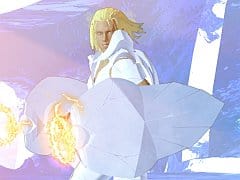Video Gamer is reader-supported. When you buy through links on our site, we may earn an affiliate commission. Prices subject to change. Learn more
“What the hell!?” is a phrase you’ll utter with alarming frequency while playing El Shaddai, which is funny, actually, given that the game centres around the politics of heaven. It’s bonkers, to return to the original point; a delirious blend of conflicting gameplay mechanics, peculiar characters and strange imagery. When you’re not swapping blows with Fallen Angels with the intention of pummelling their clothes off, you might be dodging beach balls thrown by phallic angel-demon offspring, or avoiding being knocked out of the sky by seagulls with boxing gloves for heads. What the hell, indeed.
Players assume the role of Enoch, the great grand-father of Noah, as the ancient Jewish text would have you believe. The game pulls its inspiration from the book of Enoch, in fact, which follows the young priest as he embarks on a quest to ‘purify’ seven fallen angels, who have left heaven intent on bringing a great flood to the Earth below. As God’s chosen one, it’s your job to put things right.
It’s a grandiose plot to tackle, juxtaposing the madness of everything else nicely. It’s complimented perfectly by the visuals, too, which are the unquestionable highlight of the game. The art style moves through countless themes and colour palettes, the only common thread being how weird and wonderful it all is. You’ll pass through a mountain range brought to life with pale-blue watercolours, Tron-like lairs formed from an ensemble of cubes and pulsing neon edges, and 2D halls whose walls are a canvas for shadow puppets engaged in fierce battle. A big part of the game’s appeal is anticipating what visual treats the next level has in store.
So, after donning a suit of white armour that doesn’t quite cover his topless body, Enoch – with his long blonde hair and chiselled features – leaves heaven to kick some Fallen Angel-ass. Combat plays a big role in the game, as you might imagine, with numerous parallels to Devil May Cry and Bayonetta. With one button for attacking, one for blocking, and one for jumping, it might seem pretty simple in comparison to the aforementioned titles, but there’s slightly more to it than just this.
Enoch has the ability to wield one of three weapons: the Arch, a curved blade that allows him to float outside of battle; the Gale, which fires a flurry of projectiles whilst also permitting a quick-dash ability; and the Veil, a pair of gauntlets that double up as a shield. Knowing which weapon to use for which enemy is important. The trouble is, you can only hold onto one at a time, so if you fancy a change, you’ll need to steal the required weapon from an unconscious enemy first.
It’s a simple system, but there’s a surprising amount of subtlety to it. There’s a tendency to mash on the attack button initially, but this won’t get you much further than the first few levels. Timing is crucial, and you’ll need to slip into the correct button-pressing rhythm to pull off longer combos. This comes with its own problems, though. Enoch often gets lost in the midst of a drawn-out attack animation, which you’ll occasionally want to cancel when you realise you’re about to become the victim of some ferocious attack. You can’t though. Once Enoch starts a combo, he’s doomed to carry out his animations until its done. Often this means taking a demon foot to the face and losing half your health.
Combat is just one facet of the El Shaddai experience, of course. Each brawl is knitted together with a devilish blend of bottomless chasms, swinging pendulums and spinning platforms, requiring perfect timing and quick reflexes to navigate safely. These platform sections play out across both 2D and 3D environments, with the latter suffering slightly with the extra dimension. Even with a double-jump as standard, things get pretty hard – partly because it’s supposed to be, and partly because judging distance is marred by the camera, which can’t be controlled by the player. Even so, these sections are largely enjoyable, with interesting geometry and situations that wouldn’t be out of place in something like Mario Galaxy.
El Shaddai takes its time to conform to any sort of formula. It flits so quickly between arena-based scraps to 2D platform sections and motorbike driving-brawls (yes, motorbike driving-brawls) that it can feel quite disjointed at first. Eventually things start to fall into place, though. Each section is punctuated with a boss, usually one of the seven Fallen Angels you’ve been sent to purify. The plot surrounding this suffers the same disjointed feel, but fails to come together like everything else. It’s obtuse and intentionally nonsensical, but ultimately this works in the game’s favour, complimenting the bizarreness of it all.
It’s a collection of little things that make El Shaddai such a memorable experience; the way your game is saved through Lucifel, who makes a phone call to God to ‘report your progress’; the way Amaros, one of the Fallen Angels, struts about in the middle of combat – one of my favourite walk animations since Cabanela in Ghost Trick; the way each death is marked with a snap of Lucifel’s fingers. It can feel a little dated in terms of its approach to combat, but the game is so beautiful, so different, so utterly weird and wonderful that this is of no real consequence.

/https://oimg.videogamer.com/images/e170/el_shaddai_ascension_of_the_metatron_38.jpg)